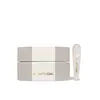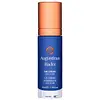What's inside
What's inside
 Key Ingredients
Key Ingredients

 Benefits
Benefits

 Concerns
Concerns

 Ingredients Side-by-side
Ingredients Side-by-side

Water
Skin ConditioningCaprylic/Capric Triglyceride
MaskingButyrospermum Parkii Butter
Skin ConditioningCocos Nucifera Oil
MaskingGlycerin
HumectantElaeis Guineensis Oil
EmollientPolyglyceryl-10 Stearate
Skin ConditioningAloe Barbadensis Leaf Juice
Skin ConditioningPropanediol
SolventLecithin
EmollientSodium Cocoyl/Stearoyl (Alanine/Arginine/Asparagine/Aspartic Acid/Glutamic Acid/Glutamine/Glycine/Histidine/Isoleucine/Leucine/Lysine/Phenylalanine/Proline/Serine/Threonine/Tyrosine/Valine)
EmollientBacillus/Folic Acid Ferment Filtrate Extract
AntioxidantCaprylyl Glycol
EmollientButylene Glycol
HumectantPolysorbate 20
EmulsifyingPolyglyceryl-6 Distearate
EmulsifyingGlycosphingolipids
EmollientGlycolipids
Skin ConditioningMethylglucoside Phosphate
Skin ConditioningCopper Lysinate/Prolinate
Skin ConditioningHydrolyzed Hyaluronic Acid
HumectantLavandula Angustifolia Oil
MaskingPhytosphingosine
Skin ConditioningFerulic Acid
AntimicrobialRetinyl Palmitate
Skin ConditioningAdansonia Digitata Seed Oil
EmollientHydrolyzed Linseed Extract
Skin ConditioningAllantoin
Skin ConditioningResveratrol
AntioxidantPichia/Resveratrol Ferment Extract
Skin ConditioningErgothioneine
AntioxidantRosmarinus Officinalis Leaf Extract
AntimicrobialXanthan Gum
EmulsifyingAcrylates/C10-30 Alkyl Acrylate Crosspolymer
Emulsion StabilisingSodium Hydroxide
BufferingEthylhexylglycerin
Skin ConditioningCaprylhydroxamic Acid
Water, Caprylic/Capric Triglyceride, Butyrospermum Parkii Butter, Cocos Nucifera Oil, Glycerin, Elaeis Guineensis Oil, Polyglyceryl-10 Stearate, Aloe Barbadensis Leaf Juice, Propanediol, Lecithin, Sodium Cocoyl/Stearoyl (Alanine/Arginine/Asparagine/Aspartic Acid/Glutamic Acid/Glutamine/Glycine/Histidine/Isoleucine/Leucine/Lysine/Phenylalanine/Proline/Serine/Threonine/Tyrosine/Valine), Bacillus/Folic Acid Ferment Filtrate Extract, Caprylyl Glycol, Butylene Glycol, Polysorbate 20, Polyglyceryl-6 Distearate, Glycosphingolipids, Glycolipids, Methylglucoside Phosphate, Copper Lysinate/Prolinate, Hydrolyzed Hyaluronic Acid, Lavandula Angustifolia Oil, Phytosphingosine, Ferulic Acid, Retinyl Palmitate, Adansonia Digitata Seed Oil, Hydrolyzed Linseed Extract, Allantoin, Resveratrol, Pichia/Resveratrol Ferment Extract, Ergothioneine, Rosmarinus Officinalis Leaf Extract, Xanthan Gum, Acrylates/C10-30 Alkyl Acrylate Crosspolymer, Sodium Hydroxide, Ethylhexylglycerin, Caprylhydroxamic Acid
Water
Skin ConditioningCaprylic/Capric Triglyceride
MaskingPentylene Glycol
Skin ConditioningPropylene Glycol
HumectantHydrogenated Phosphatidylcholine
EmulsifyingGlycerin
HumectantSorbitol
HumectantTocopheryl Acetate
AntioxidantButyrospermum Parkii Butter
Skin ConditioningXanthan Gum
EmulsifyingButylene Glycol
HumectantPanthenol
Skin ConditioningSodium Carbomer
Emulsion StabilisingAloe Barbadensis Leaf Juice
Skin ConditioningAlcohol
AntimicrobialHydrolyzed Rice Protein
Skin ConditioningSqualane
EmollientHelianthus Annuus Seed Oil
EmollientPhenoxyethanol
PreservativeSodium Hydroxide
BufferingCarbomer
Emulsion StabilisingLecithin
EmollientCholesterol
EmollientHydrogenated Lecithin
EmulsifyingAscorbyl Palmitate
AntioxidantCeramide NP
Skin ConditioningGlycine Soja Protein
EmulsifyingSuperoxide Dismutase
AntioxidantCitric Acid
BufferingDextran
Palmitoyl Tripeptide-8
Skin ConditioningAlanyl Glutamine
HumectantArginine
MaskingCeramide Ng
Skin ConditioningGlycine
BufferingLysine
Skin ConditioningOleic Acid
EmollientPalmitic Acid
EmollientPhenylalanine
MaskingProline
Skin ConditioningScenedesmus Rubescens Extract
Skin ConditioningAscorbic Acid
AntioxidantRetinyl Palmitate
Skin ConditioningSodium Benzoate
MaskingPotassium Sorbate
PreservativeEthylhexylglycerin
Skin ConditioningSodium Dextran Sulfate
Gel FormingBetula Alba Oil
MaskingDisodium EDTA
Oligopeptide-177
Sodium Ascorbate
AntioxidantTocopherol
AntioxidantWater, Caprylic/Capric Triglyceride, Pentylene Glycol, Propylene Glycol, Hydrogenated Phosphatidylcholine, Glycerin, Sorbitol, Tocopheryl Acetate, Butyrospermum Parkii Butter, Xanthan Gum, Butylene Glycol, Panthenol, Sodium Carbomer, Aloe Barbadensis Leaf Juice, Alcohol, Hydrolyzed Rice Protein, Squalane, Helianthus Annuus Seed Oil, Phenoxyethanol, Sodium Hydroxide, Carbomer, Lecithin, Cholesterol, Hydrogenated Lecithin, Ascorbyl Palmitate, Ceramide NP, Glycine Soja Protein, Superoxide Dismutase, Citric Acid, Dextran, Palmitoyl Tripeptide-8, Alanyl Glutamine, Arginine, Ceramide Ng, Glycine, Lysine, Oleic Acid, Palmitic Acid, Phenylalanine, Proline, Scenedesmus Rubescens Extract, Ascorbic Acid, Retinyl Palmitate, Sodium Benzoate, Potassium Sorbate, Ethylhexylglycerin, Sodium Dextran Sulfate, Betula Alba Oil, Disodium EDTA, Oligopeptide-177, Sodium Ascorbate, Tocopherol
Ingredients Explained
These ingredients are found in both products.
Ingredients higher up in an ingredient list are typically present in a larger amount.
Aloe Barbadensis Leaf Juice comes from leaves of the aloe plant. Aloe Barbadensis Leaf Juice is best known for helping to soothe sunburns. It is also anti-inflammatory, moisturizing, antiseptic, and can help heal wounds.
Aloe is packed with good stuff including Vitamins A, C, and E. These vitamins are antioxidants, which help fight free-radicals and the damage they may cause. Free-radicals are molecules that may damage your skin cells, such as pollution.
Aloe Barbadensis Leaf Juice also contains sugars. These sugars come in the form of monosaccharides and polysaccharides, folic acid, and choline. These sugars are able to help bind moisture to skin.
It also contains minerals such as calcium, 12 anthraquinones, fatty acids, amino acids, and Vitamin B12.
Learn more about Aloe Barbadensis Leaf JuiceButylene Glycol (or BG) is used within cosmetic products for a few different reasons:
Overall, Butylene Glycol is a safe and well-rounded ingredient that works well with other ingredients.
Though this ingredient works well with most skin types, some people with sensitive skin may experience a reaction such as allergic rashes, closed comedones, or itchiness.
Learn more about Butylene GlycolThis ingredient is also known as shea butter. It is an effective skin hydrator and emollient.
Emollients help soothe and soften your skin. It does this by creating a protective film on your skin. This barrier helps trap moisture and keeps your skin hydrated. Emollients may be effective at treating dry or itchy skin.
Shea butter is rich in antioxidants. Antioxidants help fight free-radicals, or molecules that may harm the body. It is also full of fatty acids including stearic acid and linoleic acid. These acids help replenish the skin and keep skin moisturized.
While Shea Butter has an SPF rating of about 3-4, it is not a sunscreen replacement.
Shea butter may not be fungal acne safe. We recommend speaking with a professional if you have any concerns.
Learn more about Butyrospermum Parkii ButterThis ingredient is an emollient, solvent, and texture enhancer. It is considered a skin-softener by helping the skin prevent moisture loss.
It helps thicken a product's formula and makes it easier to spread by dissolving clumping compounds.
Caprylic Triglyceride is made by combining glycerin with coconut oil, forming a clear liquid.
While there is an assumption Caprylic Triglyceride can clog pores due to it being derived from coconut oil, there is no research supporting this.
Learn more about Caprylic/Capric TriglycerideEthylhexylglycerin (we can't pronounce this either) is commonly used as a preservative and skin softener. It is derived from glyceryl.
You might see Ethylhexylglycerin often paired with other preservatives such as phenoxyethanol. Ethylhexylglycerin has been found to increase the effectiveness of these other preservatives.
Glycerin is already naturally found in your skin. It helps moisturize and protect your skin.
A study from 2016 found glycerin to be more effective as a humectant than AHAs and hyaluronic acid.
As a humectant, it helps the skin stay hydrated by pulling moisture to your skin. The low molecular weight of glycerin allows it to pull moisture into the deeper layers of your skin.
Hydrated skin improves your skin barrier; Your skin barrier helps protect against irritants and bacteria.
Glycerin has also been found to have antimicrobial and antiviral properties. Due to these properties, glycerin is often used in wound and burn treatments.
In cosmetics, glycerin is usually derived from plants such as soybean or palm. However, it can also be sourced from animals, such as tallow or animal fat.
This ingredient is organic, colorless, odorless, and non-toxic.
Glycerin is the name for this ingredient in American English. British English uses Glycerol/Glycerine.
Learn more about GlycerinLecithin is a term for a group of substances found in the cell membranes of plants, animals, and humans. They are made up of mixture of phospholipids.
This ingredient has emollient and emulsifying properties.
As an emollient, lecithen helps soften the skin and creates a barrier to keep moisture in.
As an emulsifier, it also helps prevent water and oil ingredients from separating. Lecithin can also help ingredients be better absorbed by the skin.
This is because the phospholipids in lecithin produce liposomes. Liposomes help other ingredients get through the skin barrier.
Depending on the source of this ingredient, lecithin may not be fungal acne safe. This is because some sources of lecithin come from soybean oil, which may feed the malassezia yeast that feeds fungal acne.
We recommend reaching out to the brand you are purchasing from to inquire about the source of their lecithin.
Some other names for this ingredient include soy lecithin and deoiled soy lecithin.
Learn more about LecithinRetinyl palmitate is a form of retinoid. Retinoids are the superstar class of anti-aging ingredients that include tretinoin and retinol.
This particular ingredient has had a bumpy year with its rise and fall in popularity.
First, Retinyl palmitate is created from palmitic acid and retinol. It is a retinol ester and considered one of the weaker forms of retinoid.
This is because all retinoids have to be converted to Tretinoin, AKA retinoic acid. Retinyl Palmitate is pretty far down the line and has to go through multiple conversions before its effects are seen.
Due to this long and ineffective conversion line, the benefits of Retinyl Palmitate are debated.
Studies show Retinyl Palmitate to help:
Dermatologists say this ingredient is ineffective because it isn't used in high enough concentrations in cosmetics.
This ingredient used to be found in sunscreens to boost the efficacy of sunscreen filters.
The downfall of Retinyl Palmitate was due to released reports about the ingredient being correlated to sun damage and skin tumors.
While there is a study showing this ingredient to cause DNA damage when exposed to UV-A, there is no concrete proof of it being linked to skin cancer. It is safe to use when used correctly.
All retinoids increase your skin's sensitivity to the sun in the first few months of usage. Be especially careful with reapplying sunscreen when using any form of retinoid.
Currently, this ingredient is still allowed in cosmetics all over the world. In Canada, cosmetics must have a warning label stating the product to contain Retinyl Palmitate
Fun fact: This ingredient is often added to low-fat milk to increase the levels of Vitamin A.
Learn more about Retinyl PalmitateSodium Hydroxide is also known as lye or caustic soda. It is used to adjust the pH of products; many ingredients require a specific pH to be effective.
In small amounts, sodium hydroxide is considered safe to use. However, large amounts may cause chemical burns due to its high alkaline.
Your skin has a natural pH and acid mantle. This acid mantle helps prevent harmful bacteria from breaking through. The acid mantle also helps keep your skin hydrated.
"Alkaline" refers to a high pH level. A low pH level would be considered acidic.
Learn more about Sodium HydroxideWater. It's the most common cosmetic ingredient of all. You'll usually see it at the top of ingredient lists, meaning that it makes up the largest part of the product.
So why is it so popular? Water most often acts as a solvent - this means that it helps dissolve other ingredients into the formulation.
You'll also recognize water as that liquid we all need to stay alive. If you see this, drink a glass of water. Stay hydrated!
Learn more about WaterXanthan gum is used as a stabilizer and thickener within cosmetic products. It helps give products a sticky, thick feeling - preventing them from being too runny.
On the technical side of things, xanthan gum is a polysaccharide - a combination consisting of multiple sugar molecules bonded together.
Xanthan gum is a pretty common and great ingredient. It is a natural, non-toxic, non-irritating ingredient that is also commonly used in food products.
Learn more about Xanthan Gum